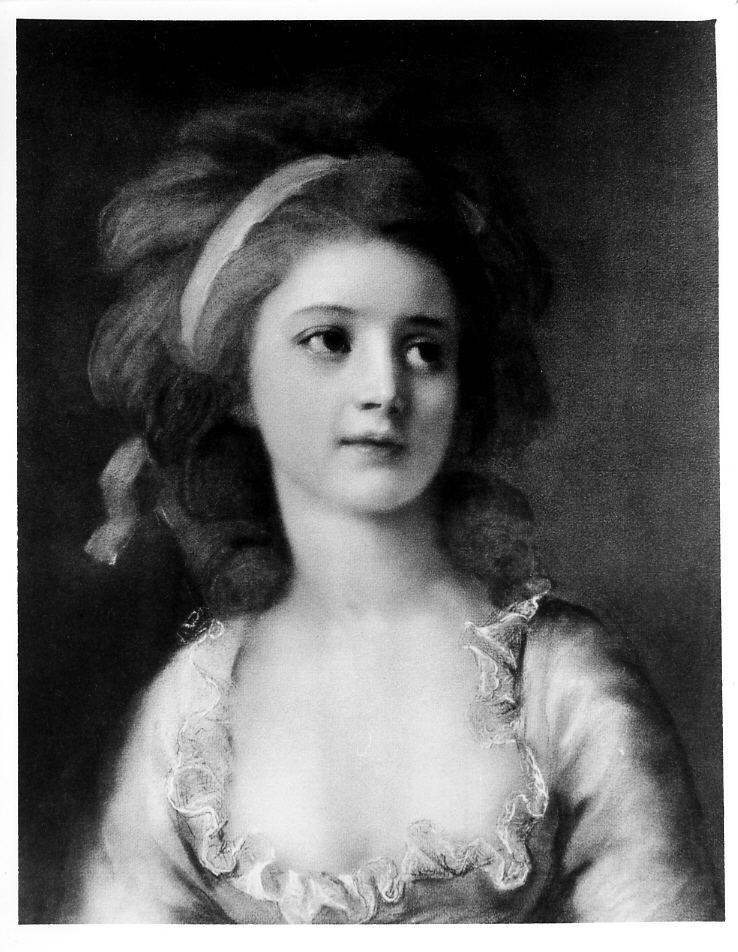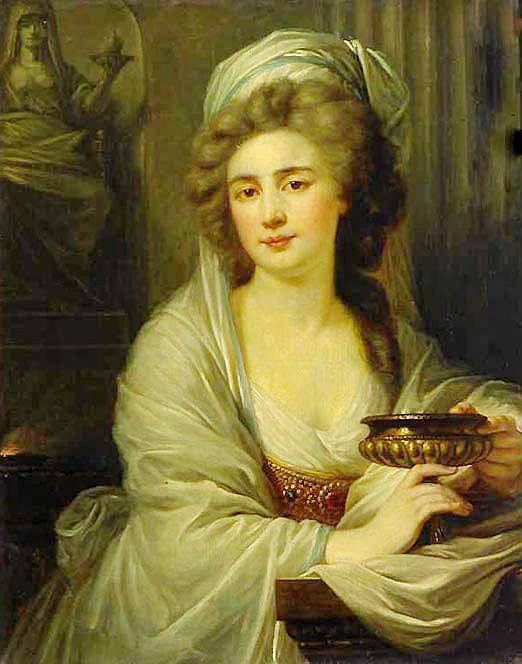Father Constantine Clavone Children Olga Potocka Parents Constantine Clavone | Name Zofia Potocka Mother Maria Clavone | |
 | ||
Husbands Jozef WittStanislaw Szczesny Potocki Role Stanislaw Szczesny Potocki's wife Spouse Stanislaw Szczesny Potocki (m. 1798–1805) Similar People Stanislaw Szczesny Potocki, Gertruda Komorowska, Franciszek Salezy Potocki, Mieczyslaw Franciszek Potocki | ||
Zofia Potocka née Clavone (Ukrainian: Софія Костянтинівна Потоцька; 11 January 1760 – 24 November 1822) was a Greek slave courtesan and a Russian agent, later a Polish noble. She was famous in contemporary Europe for her beauty and adventurous life. During the Russo-Turkish War (1787–92), she was the lover of the Russian commander prince Grigory Potemkin and acted as an agent in Russian service.
Contents

Compatriots of her time wrote: "She was beautiful as a dream, a child of southern countries. All those who have seen her admire her beauty, igniting a fire in the hearts of men and envy in the eyes of women."

Early life

Potocka was born in 1760 January 1 (January 11, New Style) in the Turkish city of Bursa to Constantine Clavone, a poor Greek cattle merchant, and Maria Clavone. In 1772, when Zofia was 12 years old, she moved to the Greek district of Phanar in Constantinople with her parents and sisters.

Around 1775, when Zofia was 15 years old, her father Constantine died under mysterious circumstances. Her mother married an Armenian, who also died. During the great fire in Constantinople, their house burned down. In this difficult time for them, her mother Maria sought support from foreign embassies.

In May 1777, when Zofia was not yet 17 years old, Maria sold her two daughters to the Polish Ambassador, Boskamp Lyasopolskomu. The ambassador was known to procure girls for the Polish king. Learning about their supposed noble origin and seeing the beauty of the girls, the Ambassador agreed to help. The sister were claimed to descent from the noble aristocratic family Pantalisa Mavrokordato, who stemmed from the royal family of Greece and was related by blood to the rulers of Byzantium.

Zofia and her sister settled in his palace and was given lessons in French. Reportedly, the ambassador kept her as his mistress for a time, and then prostituted her. Boskamp-Lyasopolsky arranged for her sister to be sold as a wife to a Turkish Pasha, but he promised her mother to arrange marriage for Zofia in Europe.
The Polish Count Major Józef Witt learned the purpose of the trip and her ancient lineage. He made an offer, bought her from Boskamp-Lyasopolsky and married her in 1779. Józef Witt was the son of the commandant of the fortress Kamianetska, and the couple lived a year in Kamianets-Podilskyi, before departing for Europe in 1781.
Europe
Zofia reportedly made a sensational success when being introduced to the aristocracy by her spouse in the drawing room receptions of Europe in the palaces of Berlin and Hamburg, Vienna, Rome, Venice and, most famously, in Paris. She was celebrated as "The most beautiful woman in Europe" and known for her expression: "My eyes aches". Her beauty and admired ability to improvise herself out of difficult situations resulted in an admiration and love affairs with several of the most powerful personalities of Europe at the time, which attracted a lot of attention. She was regarded as fashionable decoration at every party in high society in the cities they visited, and was courted by monarchs and ministers.
At the beginning of their European tour, the couple visited Warsaw. In early March 1781 she was called to court to be introduced to King Stanislas Augustus. After Warsaw they visited Berlin, where Zofia was introduced to the King of Prussia Frederick II. In the resort town of Spa, Zofia was introduced to the Austrian Emperor Joseph II, who was reportedly so fascinated and impressed by her that he ordered Mozart to compose music on the Turkish harem theme. In one of his letters to his sister, the French queen Marie Antoinette, Joseph II recommended the Witte couple to her.
Zofia saw Marie Antoinette at Petit Trianon, which at that time was being rebuilt in a landscaped park. This was possibly were Zofia was inspired to create a similar park. Reportedly, Marie Antoinette was charmed by her and spoke of her as her adopted daughter. During her stay in Paris, Zofia became the lover of both of the French king's brothers; the Count of Provence, later King Louis XVIII, and the Comte d'Artois, the future French king Charles X respectively.
On November 17, 1781 Zofia gave birth in Paris to a son. When this news reached the Polish king, her personally visited Kamianets and congratulated her father-in-law Josef Witt with the birth of a grandson, promoted him to the rank of Lieutenant General and volunteered to be the godfather of the newborn.
Russia
In 1782, the couple returned to Kamianets visiting Vienna, Moravia, Slovakia and Galicia on the way. In 1785, her spouse Joseph Witte succeeded his father as commandant of Kamianets-Podilskyi, making Zofia first lady of Podolia.
During the Russo-Turkish War (1787–92), she entered a relationship with the Russian prince Potemkin, the commander of Catherine the Great, which lasted until his death. At least during the Siege of Khotyn, her spouse managed Potemkin's net of agents in Southern Poland and his spy contacts within Chotin: in practice, however, these contacts was likely managed by, or at least with the assistance of Zofia, whose elder sister was married to the Turkish pasha of Chotin. Potemkin appointed her spouse governor of Cherson, and gave Zofia the informal task of managing the Turkish-Polish relations. In 1791, she accompanied Potemkin to Saint Petersburg, where she was introduced to the nobility as his official mistress.
Later life
In February 1796, Zofia arrived in Uman and announced her divorce from Jozef De Witte. In April 17, 1798 in Tulchin, she remarried Stanisław Szczęsny Potocki, who had divorced his wife in order to marry her. The wedding ceremony was conducted with the participation of the Orthodox priest and Catholic priest in an Orthodox Church.
During her second marriage, Zofia had three sons; Alexander (born in 1798), Mieczyslaw (born in 1800) and Boleslaw (born in 1805), and two daughters; Sophia, and Olga (1802-1861). During the marriage, she also had an affair with her stepson, Szczęsny Jerzy Potocki, who may have been the biological father of her son Boleslaw. She also had an affair with the Russian governor, Nikolai Novosiltsov. Stanisław Szczęsny Potocki indulged in mysticism and came under the influence of Polish "Illuminati" and died in March 15, 1805, without having time to say goodbye to her. As a widow, she was by law only entitled to her dowry and a small portion of the fortune of her late spouse, which would have had a bad effect on her economy as she had brought no dowry to the marriage; however, she managed to inherit almost all of the fortune of her late spouse with the assistance of her stepson and the Russian governor, both of whom were her lovers.
As a widow, Zofia reportedly occupied herself with the upbringing of her children and charitable activities. Looking back on her time in Russia, she described Potemkin as a brother.
Death
In the early 1820s, she experienced a deteriorated health. Reportedly, the mysticism of the Polish Illuminati was suspected to have affected her health. She left for Berlin to consult German doctors, where she died.
She left instructions to be buried Uman. Zofia's embalmed body was clothed in a beautiful dress and placed in a carriage, in one hand a bouquet and in the other a fan. Her body was transported in such a way across the border. In Uman, an elabourate funeral ceremony was conducted out of respect pfor the charity of her last years. When the Zofia's coffin was carried 10 miles along the road, barrels of resin were placed for lighting torches, lighting the way as the procession passed the night before a huge crowd.
Zofia was buried in the crypt under the Basilian church. In 1877, the body was disturbed as church was badly damaged by an earthquake. Zofia's remains were reburied in Talnoe with those of her youngest daughter Olga, where they still rest in the crypt of the church.
Zofia Potocka died in on 24 November 1822, aged 62.
